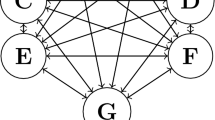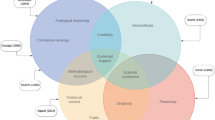Abstract
The proposition that Tweety is a bird coheres better with the proposition that Tweety has wings than with the proposition that Tweety cannot fly. This relationship of contrastive coherence is the focus of the present paper. Based on recent work in formal epistemology we consider various possibilities to model this relationship by means of probability theory. In a second step we consider different applications of these models. Among others, we offer a coherentist interpretation of the conjunction fallacy.
Similar content being viewed by others
Notes
A different example is given by Bovens and Hartmann in their Tokyo murder case (cf. Bovens and Hartmann 2003, p. 39f.).
An analysis of the coherence measures to be introduced in the next section shows disagreement with respect to this test case (proof omitted).
In a recent anthology, Martin Blauw even speaks of a “contrastivist movement” in philosophy (Blauw 2013, p. 1).
Note that the case for the pair \(((\dagger _d),(\dagger _J))\) is so far unsettled.
\((\dagger _l)\) satisfies (QD) provided that division by zero is equated with infinity. Alternatively, an ordinally equivalent measure put forward by Kemeny and Oppenheim (1952) can be used.
Condition (D3) is similar to the Bovens–Olsson condition that is well-known in the literature on measuring coherence (cf. Bovens and Olsson 2000, p. 688). In contrast to (D3), the Bovens–Olsson condition considers one pair of propositions with respect to two different probability distributions where (D3) only pertains to cases where two different pairs of propositions are assessed with respect to one probability distribution. For an assessment of (a generalized form of) the Bovens–Olsson condition with respect to probabilistic measures of coherence see Schippers (2015). (D3) itself is discussed by Glass (2007) as a condition for ranking different explanations.
There is a small caveat in this observation: so far the case of \((\dagger )_z\) is unsettled, i.e. I have neither been able to prove that it does satisfy (D3) nor have I been able to find a counterexample using Branden Fitelson’s PrSAT (see Fitelson 2008).
Based on the close relationship between the concepts of coherence and explanation, Siebel even argues in these papers for the impossibility of probabilistically measuring coherence. Starting from the observation that the concept of explanation cannot be reduced to probability, Siebel concludes that “if probabilistic accounts cannot cope with explanation, they will hardly be able to deal with coherence because, as BonJour (1985) and many others have pointed out, coherence is a function of explanation.” For a rebuttal see Roche and Schippers (2013).
Note that this inequality is the common core of various measures of explanatory power (Good 1960; McGrew 2003; Schupbach and Sprenger 2011; Crupi and Tentori 2012), that is, each of these measures \({\mathscr {E}}_{\Pr }(e,h)\) that quantify the degree of explanatory power that h provides for e (given \(\Pr \)) satisfies the following principle for any contingent \(e,h_1,h_2\) and any regular probability \(\Pr \) (cf. Crupi and Tentori 2012):
$$\begin{aligned} {\mathscr {E}}_{\Pr }(e,h_1)\gtreqless {\mathscr {E}}_{\Pr }(e,h_2) \quad \text { iff}\quad \Pr (e|h_1)\gtreqless \Pr (e|h_2) \end{aligned}$$Measures that satisfy \((\ddagger )\) are (among others) d, l, r, z, ku, Shogenji’s justification measure J and Kemeny and Oppenheim’s (1952) measure k.
Another interpretation of the conjunction fallacy is given by Shogenji (2012). There, Shogenji shows that conditions (3) and (4) also imply that the conjunctive hypothesis \(b\wedge f\) is more justified by e than b, as measured by his justification measure J. Given that J also satisfies \((\ddagger )\), we also know that the degree justification-based coherence as measured by \({\mathscr {C}}_J\) is higher for the conjunctive hypothesis.
References
Blauw, M. (Ed.). (2013). Contrastivism in philosophy. New York: Routledge.
BonJour, L. (1985). The structure of empirical knowledge. Cambridge: Harvard University Press.
Bovens, L., & Hartmann, S. (2003). Bayesian epistemology. Oxford: Oxford University Press.
Bovens, L., & Olsson, E. J. (2000). Coherentism, reliability and Bayesian networks. Mind, 109, 685–719.
Brössel, P. (2013). The problem of measure sensitivity redux. Philosophy of Science, 80, 378–397.
Chandler, J. (2007). Solving the tacking problem with contrast classes. British Journal for the Philosophy of Science, 58, 489–502.
Chandler, J. (2013). Contrastive confirmation: Some competing accounts. Synthese, 190, 129–138.
Chart, D. (2001). Inference to the best explanation, Bayesianism, and feminist bank tellers. Online-paper. http://philsci-archice.pitt.edu/documents/disk0/00/00/03/22/.
Crupi, V., Festa, R., & Buttasi, C. (2010). Towards a grammar of Bayesian confirmation. In M. Surez, M. Dorato, & M. Rdei (Eds.), Epistemology and methodology of science (pp. 73–93). Berlin: Springer.
Crupi, V., Fitelson, B., & Tentori, K. (2008). Probability, confirmation, and the conjunction fallacy. Thinking and Reasoning, 14, 182–199.
Crupi, V., & Tentori, K. (2012). A second look at the logic of explanatory power (with two new representation theorems). Philosophy of Science, 79, 365–385.
Crupi, V., Tentori, K., & Gonzalez, M. (2007). On Bayesian measures of evidential support: Theoretical and empirical issues. Philosophy of Science, 74, 229–252.
de Finetti, B. ([1937] 1980). Foresight: Its logical laws, its subjective sources. In H. E. Kyburg, Jr. & H. E. Smokler (Eds.), Studies in subjective probability (2nd ed., pp. 53–118). Huntington, NY: Robert E. Krieger.
Douven, I., & Meijs, W. (2007). Measuring coherence. Synthese, 156, 405–425.
Eells, E., & Fitelson, B. (2000). Measuring confirmation and evidence. Journal of Philosophy, 97, 663–672.
Fitelson, B. (1999). The plurality of Bayesian measures of confirmation and the problem of measure sensitivity. Philosophy of Science, 66, 362–378.
Fitelson, B. (2003). A probabilistic theory of coherence. Analysis, 63, 194–199.
Fitelson, B. (2007). Likelihoodism, Bayesianism, and relational confirmation. Synthese, 156, 473–489.
Fitelson, B. (2008). A decision procedure for probability calculus with applications. The Review of Symbolic Logic, 1, 111–125.
Gigerenzer, G. (1994). Why the distinction between single-event probabilities and frequencies is important for psychology (and vice versa). In G. Wright & P. Ayton (Eds.), Subjective probability (pp. 129–161). New York: Wiley.
Gigerenzer, G. (1996). On narrow norms and vague heuristics: A rebuttal to Kahneman and Tversky. Psychological Review, 103, 592–596.
Gigerenzer, G. (2001). Content-blind norms, no norms, or good norms? A reply to Vranas. Cognition, 81, 93–103.
Glass, D. H. (2002). Coherence, explanation, and Bayesian networks. In M. ONeill, et al. (Eds.), Artificial intelligence and cognitive science (pp. 177–182). Berlin: Springer.
Glass, D. H. (2007). Coherence measures and inference to the best explanation. Synthese, 157, 275–296.
Good, I. J. (1960). Weight of evidence, corroboration, explanatory power, information and the utility of experiments. Journal of the Royal Statistical Society (Series B), 22, 319–331.
Grice, H. P. (1975). Logic and conversation. Studies in the way of words (pp. 22–40). Cambridge, MA: Harvard University Press.
Hertwig, R., & Chase, V. M. (1998). Many reasons or just one: How response mode affects reasoning in the conjunction problem. Thinking and Reasoning, 4, 319–352.
Hertwig, R., & Gigerenzer, G. (1999). The ‘conjunction fallacy’ revisited: How intelligent inferences look like reasoning errors. Journal of Behavioral Decision Making, 12, 275–305.
Hitchcock, C. R. (1996). The role of contrast in causal and explanatory claims. Synthese, 107, 395–419.
Hitchcock, C. D. (1999). Contrastive explanation and the demons of determinism. British Journal for the Philosophy of Science, 50, 585–612.
Joyce, J. (2004). Bayes’s theorem. In E. N. Zalta (Ed.). The Stanford encyclopedia of philosophy (Summer 2004 ed.). http://plato.stanford.edu/archives/sum2004/entries/bayes-theorem/.
Kahneman, D., & Tversky, A. (1972). Subjective probability: A judgment of representativeness. In D. Kahneman, P. Slovic, & A. Tversky (Eds.), Judgment under uncertainty: Heuristics and biases. Cambridge: Cambridge University Press.
Kemeny, J., & Oppenheim, P. (1952). Degrees of factual support. Philosophy of Science, 19, 307–324.
Lipton, P. (1990). Contrastive explanation. In D. Knowles (Ed.), Explanation and its limits (pp. 247–266). Cambridge: Cambridge University Press.
McGrew, T. (2003). Confirmation, heuristics, and explanatory reasoning. British Journal for the Philosophy of Science, 54, 553–567.
Mellers, A., Hertwig, R., & Kahneman, D. (2001). Do frequency representations eliminate conjunction effects? An exercise in adversarial collaboration. Psychological Science, 12, 269–275.
Olsson, E. J. (2002). What is the problem of coherence and truth? The Journal of Philosophy, 99, 246–272.
Ramsey, F. P. (1926). Truth and probability. In H. E. Kyburg Jr & H. E. Smokler (Eds.), Studies in subjective probability (2nd ed., pp. 23–52). Huntington, NY: R. E. Krieger. 1980.
Reichenbach, H. (1949). The theory of probability. Berkeley: University of California Press.
Roche, W., & Schippers, M. (2013). Coherence, probability and explanation. Erkenntnis, 79, 821–828.
Royal, R. (1997). Statistical evidence: A likelihood paradigm. London: Chapman and Hall.
Schippers, M. (2014). Probabilistic measures of coherence. From adequacy constraints towards pluralism. Synthese, 191, 3821–3845.
Schippers, M. (2015). The grammar of Bayesian coherentism. Studia Logica, 103, 955–984.
Schupbach, J. N., & Sprenger, J. (2011). The logic of explanatory power. Philosophy of Science, 78, 105–127.
Shafir, E., Smith, E., & Osherson, D. (1990). Typicality and reasoning fallacies. Memory and Cognition, 18, 229–239.
Shogenji, T. (1999). Is coherence truth conducive? Analysis, 59, 338–345.
Shogenji, T. (2012). The degree of epistemic justification and the conjunction fallacy. Synthese, 184, 29–48.
Sides, A., Osherson, D., Bonini, N., & Viale, R. (2002). On the reality of the conjunction fallacy. Memory and Cognition, 30, 191–198.
Siebel, M. (2003). There’s something about Linda: Probability, coherence and rationality. Unpublished manuscript.
Siebel, M. (2005). Against probabilistic measures of coherence. Erkenntnis, 63, 335–360.
Siebel, M. (2011). Why explanation and thus coherence cannot be reduced to probability. Analysis, 71, 264–266.
Tentori, K., & Crupi, V. (2012). On the conjunction fallacy and the meaning of and yet again: A reply to Hertwig, Benz, and Krauss (2008). Cognition, 122, 123–134.
Tversky, A., & Kahneman, D. (1982). Judgments of and by representativeness. In D. Kahneman, P. Slovic, & A. Tversky (Eds.), Judgment under uncertainty: Heuristics and biases (pp. 84–98). Cambridge: Cambridge University Press.
von Mises, R. (1957). Probability, statistics and truth. New York: Macmillan.
Acknowledgments
This work was supported by Grant SI 1731/1-1 to Mark Siebel from the Deutsche Forschungsgemeinschaft (DFG) as part of the priority program “New Frameworks of Rationality” (SPP 1516).
Author information
Authors and Affiliations
Corresponding author
Rights and permissions
About this article
Cite this article
Schippers, M. Competing accounts of contrastive coherence. Synthese 193, 3383–3395 (2016). https://doi.org/10.1007/s11229-015-0937-4
Received:
Accepted:
Published:
Issue Date:
DOI: https://doi.org/10.1007/s11229-015-0937-4




